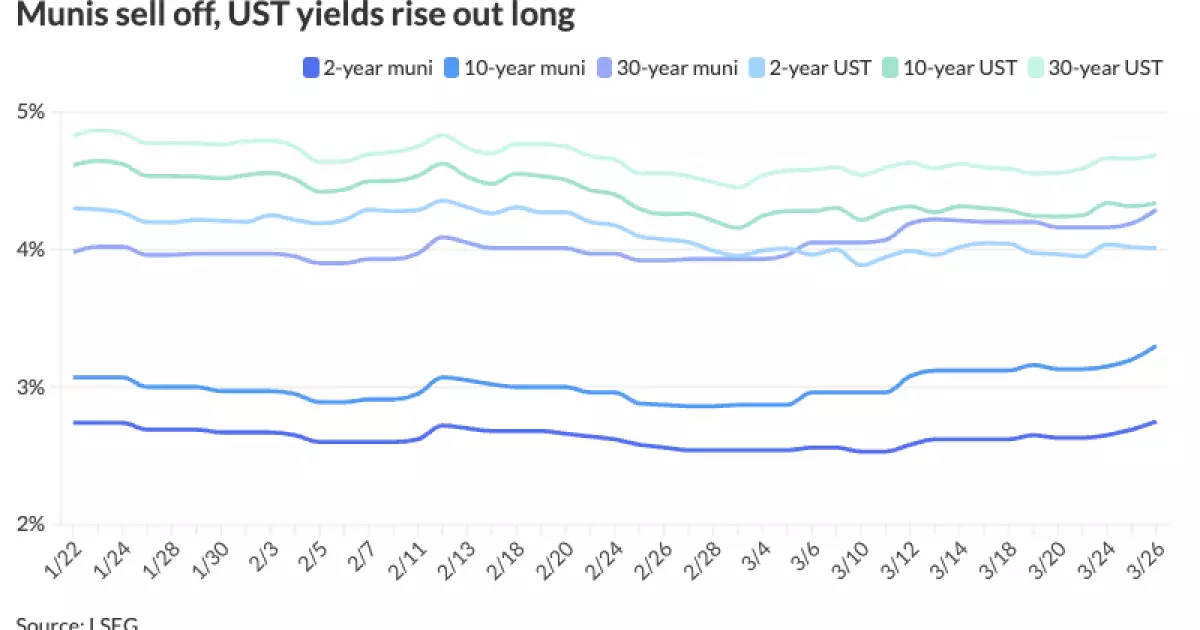Municipal bonds, long hailed as the safe haven for conservative investors, recently experienced a staggering sell-off that has rocked the market. In April, yields saw double-digit cuts, marking the second such dip in just weeks. On a day when U.S. Treasury yields climbed up to three basis points, municipal yields were forced lower by two to twelve basis points, stirring discomfort among veterans and newcomers alike. This chaotic environment should serve as a wake-up call for investors who believed these bonds were immune to broader economic turmoil.
Despite enduring high-grade status, municipal bonds seem increasingly vulnerable. Wall Street’s indiscriminate selling has raised concerns about liquidity. The Investment Company Institute reported a net inflow of only $19 million for municipal bonds in the week ending March 19, starkly contrasting last week’s inflow of $376 million. The suggestion that such a significant inflow could transform dramatically into an outflow is troubling, particularly for those still navigating the murky waters of pandemic-driven market anomalies. Is there a storm on the horizon?
A Fragile Balance: The Macro Risks Looming Large
The so-called macro-risks impacting the municipal bond market are more than minute fluctuations in interest rates or shifting inflationary concerns; they have become a veritable tar pit for investors. As James Pruskowski, CIO at 16Rock Asset Management, so aptly stated, current factors—tariffs, tax policy proposals, and uncertain economic data—are intersecting to create an unpredictable financial landscape. The earlier perception of a bulwark has crumbled: the word “caution” now echoes ominously in trading rooms from New York to Los Angeles.
Markets have historically overshot during periods of uncertainty, but as economic dislocations breed opportunity, this moment feels distinctly different. Investors loyal to municipal bonds might feel as though they are grasping at straw; today’s rising credit spreads suggest that the dislocation is more than just an inconvenient bump in the road. It may very well indicate a significant realignment of investor sentiment, and those reliant on a straightforward recovery narrative could be gravely disappointed.
The Muni-UST Ratio: A Double-Edged Sword
A closer look at the municipal-to-U.S. Treasury (UST) ratios reveals a strikingly intricate dance, often favoring USTs, but more recently taking an intriguing turn. The two-year ratio stood at 69%, with the thirty-year trailing at 92%. Reasonably, this somewhat wider ratio should represent an opportunity for astute investors looking to leap back into the market. Yet, as Ron Banaszek from Blaylock Van highlights, the market is more forgiving to seasoned institutions than to secondary traders holding risk positions.
Investors have witnessed the substantial margins of safety begin to evaporate, leaving behind an unsettling question: with the current malaise, what is the right price to attract investors? It’s less about favorable ratios and more about striking the right balance between fear and opportunity. Secondary traders are likely caught in a crossfire, and any miscalculation could prove disastrous.
Liquidity: The Phantom Menace
The liquidity crisis plaguing the municipal bond market is perhaps the most alarming development of all. Once regarded as a bastion of reliability—where high-grade bonds translated to stability—the market’s current state indicates anything but. The sudden shift in sentiment has resulted in reduced liquidity, making it increasingly complex for investors to reposition themselves in a jittery environment.
Pruskowski mentioned that “liquidity is as strained as it has been in a long time,” which complicates transactions and constricts the flow of funds. The asking prices fluctuate wildly, leaving investors in an uncertain limbo. In this climate, traditional strategies might not only falter but also wound the long-term positions investors have tirelessly built. This dire circumstance eliminates much of the confidence that typically propels municipal bond investing into a “safe” zone, leaving us grappling with the notion of a depreciating asset class.
Where Do We Go From Here?
Current market conditions are exigent, prodding investors to reevaluate their portfolios and adjust their expectations accordingly. The ubiquitous advisory to exercise patience cannot be overstated, as many stakeholders wrestle with the notion of “timing” in this unpredictable market. The lingering fear is that the needed catalyst for revitalization remains just out of reach, perhaps obscured by the very risks delineated in wide credit spreads and mediocre inflows.
The reality is this: we face an intricate web of variables that extend far beyond numbers and metrics. The decisions made today amid this uncertainty will not only affect immediate outcomes but will ripple into the future as well. Investors must therefore equip themselves with the discernment to navigate these turbulent waters, lest they find themselves lost to the market’s mercurial whims.

